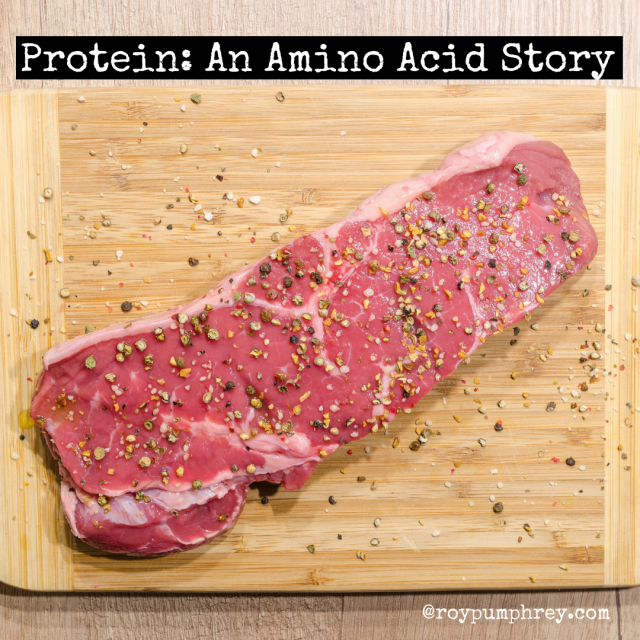
PROTEIN
Protein is EVERYWHERE these days.
But most folks don’t know what it is, what the hell it even does, how much of it you actually need and is a “protein bar” with 8 grams of protein actually a protein bar?
*It’s not.
Protein: The Building Blocks of Life
But DNA tells the body what amino acids, the building blocks of proteins, to sequence to form proteins, making for every tissue in the human body.
No protein means no muscle, bone, ligament, hair, skin, enzymes, hormones,
Protein is Essential:
“Proteins are large, complex molecules that play many critical roles in the body. They do most of the work in cells and are required for the structure, function, and regulation of the body’s tissues and organs.” – How Genes Work
You need to consume it, or you die.
That, in and of itself, doesn’t mean more is better.
It means “enough” is needed to sustain life.
Without “enough” deficiency occurs, homeostasis is disrupted, and the body starts to do awesome things.
Protein Deficiency:
Is really bad and if you want to find out all the F@cked up stuff that can happen if you have one click here and read..
Otherwise, just trust me, it’s really bad, you don’t want it.
Now, the amount you need to stave off a deficiency isn’t a ton.
In fact, it’s fairly low.
The RDA (Recommended Dietary Allowance)
Recommended Dietary Allowance (RDA): average daily level of intake sufficient to meet the nutrient requirements of nearly all (97%-98%) healthy people.
Keep this in mind, the RDA is only enough to keep 97-98% of the population alive,
sufficient,
Not THRIVING
The RDA for Protein = 0.8 Grams/ Pound/ Body Weight
In pounds that’s: Your weight X 0.36 = Protein RDA for your weight
It’s not much.
For me that’s only 70.2 grams a day.
I call that 1.5 meals.
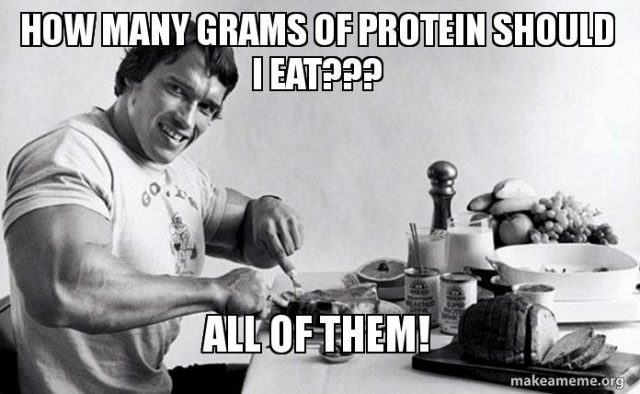
Unfortunately, misinterpreting the RDA as the optimal amount has lead to this myth frequently being repeated:
Americans Eat Too Much Protein Already
“Contrary to all the hype that everyone needs more protein, most Americans get twice as much as they need,” says Kristi Wempen, a Mayo Clinic Health System registered dietitian nutritionist. “This is especially true for males 14-70 years of age, who the 2015 Dietary Guidelines for Americans advise to decrease meat, poultry and egg consumption. Even athletes are often getting more protein than they need, without supplements, because their calorie requirements are higher. And with more food comes more protein.” – Mayo Clinic
Do we really get too much protein?
More than enough to stave off deficiency?
Yes.
We’re pretty much all covered.
But to Function Optimally?
Especially if you exercise hard regularly?
Probably not..
“A number of reports have challenged the concept of the RDA as a minimal requirement rather than a “recommended” intake of protein that is “allowed” and questioned whether more optimal health outcomes could be achieved with protein intakes greater than the RDA.” – Phillips
Too often the RDA value is applied as the optimal functioning value, even by RD’s (registered dietician) and clinicians:
“the RDA is the amount of a nutrient you need to meet your basic nutritional requirements. In a sense, it’s the minimum amount you need to keep from getting sick — not the specific amount you are supposed to eat every day.…There’s a misunderstanding not only among the public, but also somewhat in our profession about the RDA,” says Nancy Rodriguez, a registered dietitian and professor of nutritional science at the University of Connecticut in Storrs. “People in general think we all eat too much protein.”- Harvard
Remember, the RDA deals with JUST KEEPING DISEASE AWAY.
So How Much Protein Do I Need To Function Optimally?
Like most things in physiology the answer is;
It Depends…
A good, general rule, of protein intake for ACTIVE people is
“For building muscle mass and for maintaining muscle mass through a positive muscle protein balance, an overall daily protein intake in the range of 1.4–2.0 g protein/kg body weight/day (g/kg/d) is sufficient for most exercising individuals,” – ISSN Protein and Exercise
That’s roughly 0.8 grams per pound of bodyweight PER DAY.
Meatheads are not mathematicians.

We’re simple folk.
We generally just push the easy button, round-up a bit, and go with,
1 Gram of Protein, Per Pound of Body Weight, Per Day
When we use the term “active” we’re talking regularly engaged in relatively intense exercise training regularly.
For me, that’s if you’re breaking a sweat in some form almost everyday, or at least most days, that’s 4 or more kids, days a week.
Why Round Up?
1) Bioavailability.
Basically, the “quality” of the protein ingested.
In short, not all amino acids, and the amino acid profiles of different foods, are created equal
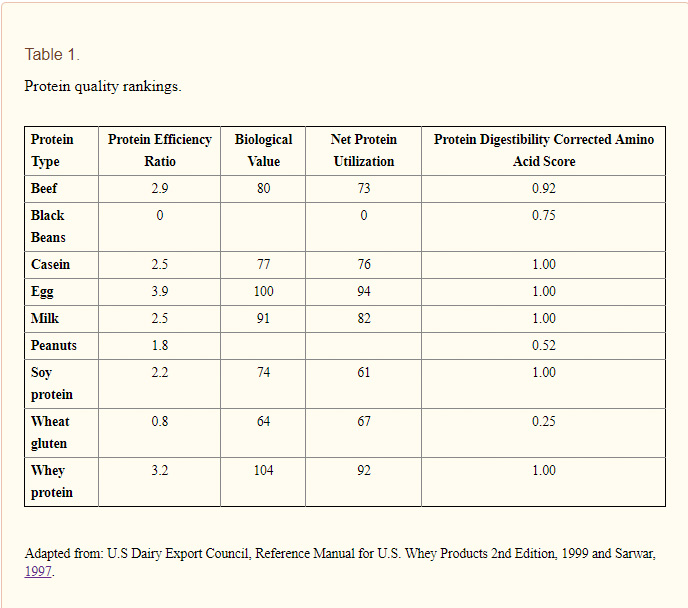
In general, animal proteins better fit the amino acid profile of humans so animal protein is more completely absorbed and used.
2) Digestibility
You don’t actually digest and assimilate all of anything that you consume.
Especially not larger, harder to breakdown, molecules such as proteins.
It’s not so much that the protein isn’t digested as it is, the process of digestion takes time, and the food train keeps moving along the digestive tract.
Some is going to be eliminated.
It’s just not sitting around long enough to be fully broken down and assimilated.
3) Gluconeogenesis
Your brain loves glucose.
The body is really sneaky.
Through Gandalf Like Magic the process of Gluconeogenesis you can make glucose from amino acids.
You’re going to “lose” some protein to other processes, besides muscle repair and growth, so round up enough to ensure you have an adequate amount for all the bodily processes.
*If you have no interest as to the “why” you need this much, STOP HERE, don’t read any farther.
Get I gram per pound of body weight each day and you’ll be good.
Things are about to get really interesting or incredibly boring.
Yes, there is a difference in the needs of aerobic vs weight training.
But, we’re going to lump them in together here because:
1) the optimal amounts are fairly close
2) this article is going to be long enough as is.
3) it doesn’t really matter because even if you slightly overconsumee protein, nothing bad is going to happen. <—-your kidneys will not explode
So if you’re ACTIVE, or as the literature often states, an “athlete”, and weigh 200lbs, you should try to consume around 200 grams of protein in a day for optimal functioning/ muscle growth etc.
Why So Much More for “Athletes”?
This need for higher levels of protein in “athletes” doesn’t just happen.
You can’t The Secret your way to a more muscular physique.
It happens because of the chronic stress placed on the structures of the body (muscles, ligaments, bones, even enzymes) and nervous system.
But when we’re talking about protein and exercise, we’re talking gainzz.
Muscle Hypertrophy
“many factors mediate the hypertrophic process and that mechanical tension, muscle damage, and metabolic stress all can play a role in exercise-induced muscle growth.” – Schoenfeld
Yes, you actually need the muscle to work harder than it is used to in one of those three ways for the body to send the signal for anabolism (growth).
This is an effort by the stressed muscle to protect against future damage, metabolic stress, or mechanical strain.
Anabolism:
Anabolism (anabolic metabolism) is the coordinated metabolic activity that allows cells to produce macromolecules. –Science Direct
Why Anabolic Steroids Work.
Contrary to the misinformation touted by the uninformed media popular opinion, anabolic steroids don’t do the work for you (well they may, in the untrained, a little).
Anabolic steroids increase the signal to not only create more of the contractile proteins (in the muscles) that heavy weight training triggers, but to also break down less muscle during training:
“Steroid hormones work by stimulation of receptor molecules in muscle cells, which activate specific genes to produce proteins. They also affect the activation rate of enzyme systems involved in protein metabolism, thus enhancing protein synthesis and inhibiting protein degradation (called an anti-catabolic effect).
Heavy resistance training seems to be necessary for anabolic steroids to exert any beneficial effect on physical performance. Most research studies that have demonstrated improved performance with anabolic steroids used experienced weight lifters who were capable of training with heavier weights and producing relatively greater muscle tension during exercise than novice subjects. The effectiveness of anabolic steroids is dependent upon unbound receptor sites in muscle. Intense strength training may increase the number of unbound receptor sites. This would increase the effectiveness of anabolic steroids.”– Sportsci.org
No Signal?
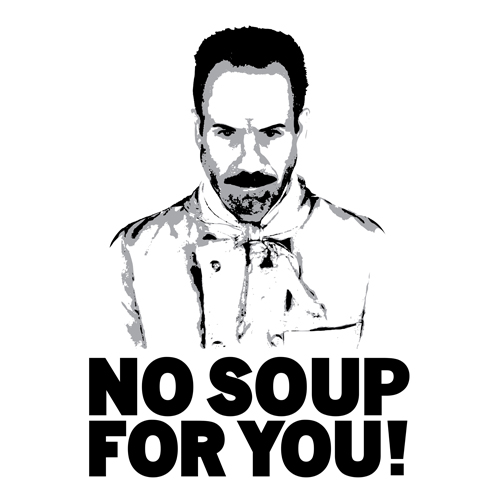
Wait, Weight Training Tears Muscles Down?
The acute catabolic effect of weight training is degradation of muscle contractile proteins.
Technically, this leads to a DECREASE in muscle tissue (on the molecular/ cellular level). <—-in the acute sense, in real life, you would NEVER notice this.
“muscle protein breakdown is increased following resistance exercise.” – Exercise Induced Changes is Protein Metabolism
However, damage to the muscle tissue is what sends the signal for the body to rebuild and lay down more muscle tissue:
“When skeletal muscle is subjected to an overload stimulus, it causes perturbations in myofibers and the related extracellular matrix. This sets off a chain of myogenic events that ultimately leads to an increase in the size and amounts of the myofibrillar contractile proteins actin and myosin, and the total number of sarcomeres in parallel. This, in turn, augments the diameter of individual fibers and thereby results in an increase in muscle cross-sectional area” – Schoenfeld
Why You Need To Consume Enough Protein:
Even if an overload stimulus signals anabolism (muscle hypertrophy) none can actually take place if there isn’t enough protein (amino acids) present in the blood to supply the raw materials for new tissue:
There is a concomitant, and qualitatively greater, increase in muscle protein synthesis following resistance exercise, which may last for as long as 48 h. Increased muscle protein synthesis is linked to increased intramuscular availability of amino acids, and thus, to increased blood flow and increased amino acid delivery to the muscle, as well as increased amino acid transport. Administration of exogenous amino acids after exercise increases protein synthesis while ameliorating protein breakdown, thus improving net muscle protein balance. While it is clear that muscle protein synthesis and protein breakdown increase in a qualitatively similar manner following exercise, the mechanisms of stimulation have yet to be determined. However, we propose that the intracellular availability of amino acids is the link between these processes. –Tipton and Wolfe
This protein availability equation, the difference between protein lost from the breakdown of muscle tissue (catabolism) and the growth of muscle tissue (anabolism) is termed,
Nitrogen Balance:
Nitrogen homeostasis is a highly regulated function. Nitrogen balance is commonly referred to as the net difference between the intake (and/or the effective absorption) of nitrogen contained in the diet and its excretion. Since nitrogen is contained predominantly in proteins, this term pertains mainly to the balance of proteins and of amino acids – Tessari
If the Goal is to Gain Muscle:
YOU MUST BE IN A POSITIVE NITROGEN BALANCE
There is physiologically no way around this.
You need to have enough protein in the system to tip the “Nitrogen Scale” to building when the anabolic signals are sent as a result of stressful resistance training.
Exercise has a profound effect on muscle growth, which can occur only if muscle protein synthesis exceeds muscle protein breakdown; there must be a positive muscle protein balance. Resistance exercise improves muscle protein balance, but, in the absence of food intake, the balance remains negative (i.e., catabolic). The response of muscle protein metabolism to a resistance exercise bout lasts for 24-48 hours; thus, the interaction between protein metabolism and any meals consumed in this period will determine the impact of the diet on muscle hypertrophy. Amino acid availability is an important regulator of muscle protein metabolism. –Exercise, Protein Metabolism and Muscle Growth
If you’re not eating enough protein to create a positive nitrogen balance the body will remain in a negative nitrogen balance, a catabolic state, in response to exercise and muscle growth wont can’t occur.
Weight Loss, Negative Nitrogen Balance and Losing Your Gains
If you go on a diet, creating a negative caloric balance, you’re going to lose weight.
The only downside to losing weight for most people is that some of it will inevitably be muscle tissue,
“The consequences of negative energy balance on total body and skeletal muscle mass are well established. In general, total body mass decreases in response to sustained periods of negative energy balance, and the proportion of body mass loss is ~75% adipose tissue and 25% fat-free mass (FFM)“- Carbone, McClung and Pasiakos
Keep in mind, this 75%/ 25% fat to muscle ratio during weight loss isn’t a hard and fast rule, its just a pretty good general rule of thumb.
Obviously, even when losing weight, we want to keep as much muscle mass as possible.
Other than athletes who are competing in a certain weight class or transitioning from strength to endurance sports, I don’t know of anyone who goes on a diet with the express intent of losing as much muscle mass as possible.
Even in the above cases it’s usually about maximizing fat loss to make-weight.
Keeping Your Gains Bro
That said, there are some strategies you can use to hold onto more muscle during times of self induced famine caloric restriction.
#1) Increase Your Protein
Increased protein intake during times of caloric restriction has consistently been shown to help decrease the amount of muscle mass or FFM (fat-free mass) lost during periods of caloric restriction.
Others have also demonstrated benefits of consuming higher protein diets during prolonged periods of negative energy balance, with consistent reports documenting the attenuation of the loss of FFM after weight loss (4, 6). Taken together, these investigations indicate that a certain degree of lean mass protection is gleaned from the consumption of a higher protein diet during prolonged periods of energy deficit.– Advances in Nutrition
Increase protein by how much?
As always, way above the RDA…
There’s no rule, but you need more protein when calories (fats and carbs) are reduced.
Not only to help with tissue repair and growth but because amino acids will be used at a greater rate for energy (gluconeogenesis),
“protein requirement is, within a certain limit, inversely dependent on energy intake, i.e. the more energy is ingested, the less protein is needed. This is because proteins can be used also as energy sources (beyond their structural, regulatory and functional role). Therefore, if their use to produce energy varies, their requirement also varies. Furthermore, alternative energy substrates, such as the carbohydrates, can stimulate insulin secretion, which in turn spares endogenous proteins.”- Tessari
The best recommendation I found was for protein intake during caloric restriction was in; Protein Requirements in Energy Restricted Lean Athletes
Instead of making blanket recommendations based off of weight, the authors based their recommendations off of FFM (fat-free mass).
The relevant studies they reviewed pointed to,
2.3-3.1 g/ kg of FFM (fat-free mass)/ per day
Protein intake as the “optimal” amount in calorie restricted, lean athletes.
Authors of that paper recommend trending toward the higher end of that recommendation if you’re leaner or trying to maximize maintenance of lean body mass.
I would say, go with that recommendation regardless of who you are if you can.
What’s the worst that happens?
Maintain your metabolism, performance and hard-earned muscle?
Ohh, what a tragedy….
#2) Keep Lifting Heavy A$$ Weights
The old school 70 and 80’s bodybuilding rule was to do “low weight, high reps” during times of caloric restriction.
This is Arnolds “low weight, high reps”
Ohh, and he was on the Juice.
That helps too
Lifting weights sends the signal to build.
“Exercise, particularly lifting weights, provides a signal for muscle to be retained even when you’re in a big calorie deficit,” – Stuart Phillips. Ph.d
If you don’t send the signal, the body will willingly jettison the metabolically “costly” muscle tissue that is eating up all the few calories you have available while you’re already in a caloric deficit.
Less muscle = Fewer calories needed.
Keep your muscles.
#3) Smaller Caloric Deficit
The smaller the deficit in calories the more “willing” your body will be to use stored fat and not amino acids for an energy source.
“Slower rates of weight loss appear to be more protective of both FFM and performance”- Helms and company
A general rule of thumb for lean athletes (10% body fat and lower in men, 15% and lower in women) in the bro world is weight loss of about 1/2lbs body weight a week is the MAXIMUM that assures most of the weight is from fat.
Granted this number can be much higher if you’re fatter.
For Most of My “Weight” Loss Clients?
2lbs Weight / Week
is the upper limit of what I would recommend.
Any greater and, in my experience, you’re going to be losing too much muscle mass to make the rate of loss worth it.
*Quick Note: If you’re obese, and have quite a bit of weight to lose, you can lose at a much greater rate than the 2lbs a week.
Older Means More, Bro-Protein That is
Here’s the long and short of it.
As we age the body start breaking down faster.
Depending on the system, this degradation can begin as early as the mid to late 20’s and the degradation continues, usually accelerating, until the end of life.
When it comes to muscle tissue the tissue degradation is called,
Sarcopenia.
The age related loss of muscle tissue and strength.
“Sarcopenia or the involuntary loss of lean muscle mass occurs commonly with aging, beginning as early as age 40 and becoming much more pronounced after age 60. Research suggests that muscle mass can be lost at a rate of 1%-2% per year after the age of 50 years. However, evidence also suggests that strength as a part of muscular fitness declines at a rate greater than the loss of muscle mass. It is postulated that strength declines at a rate of 12%-15% per decade after the 5th decade of life. – Importance of Resistance Training in the Treatment of Sarcopenia
When I was in undergrad and even grad school it was thought that sarcopenia was an inevitable consequence of aging.
I’m Calling Bullshit
We’re just moving/ exercising less and consuming inadequate protein as we age.
More and more research is emerging that sarcopenia isn’t necessarily a foregone conclusion.
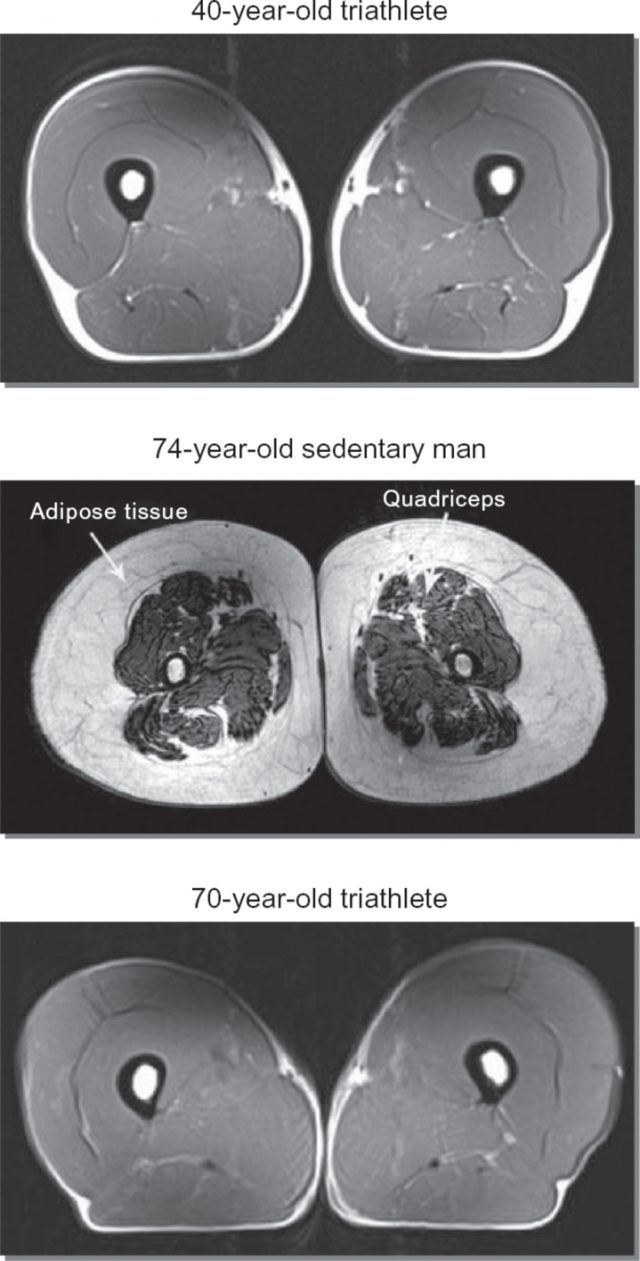
Pic is from this study: Chronic Exercise Preserves Lean Muscle Mass in Masters Athletes.
Here’s part of what the authors had to say,
“This study contradicts the common observation that muscle mass and strength decline as a function of aging alone. Instead, these declines may signal the effect of chronic disuse rather than muscle aging.” – Wroblewski and friends
A high protein intake and exercise seem to be especially effective at battling sarcopenia.
“An interesting variable that was also investigated in their study was the use of a protein enriched diet that was between 112%-150% of the recommended daily protein intake. Iglay and colleagues suggested that the sarcopenic body can also improve body composition parameters in terms of lean muscle mass through exercise training that is supplemented by a diet with a high protein intake.” – Hunt and Company
Remember, if you don’t have the, amino acid, building blocks available, you can’t rebuild or build new muscle regardless of the anabolic signal sent.
You’re Going to Need a Hell of a Lot More Than the RDA
“There is new evidence linking protein intake with sarcopenia and physical function, and recent metabolic and epidemiological studies indicate that the current Recommended Dietary Intakes for protein appear to be inadequate for maintenance of physical function and optimal health in older adults.” – Protein Requirements and Recommendations for Older People: A Review
“There is good consistent evidence (level III-2 to IV) that consumption of 1.0 to 1.3 g/kg/day dietary protein combined with twice-weekly progressive resistance exercise reduces age-related muscle mass loss.” – Nowson and O’Connell
” safe minimal protein intake would be 1.0–1.2 g/kg/day for normal healthy younger persons and at least 1.2 g/kg/day and perhaps as high as 1.4 g/kg/day for older persons.” – Phillips
Why So Much Protein?
- To prevent Sarcopenia the you need to retain muscle mass. Retention of muscle mass is contingent on:
- The signal from the muscle (anabolism)
- Ample amino acids being available to rebuild the contractile proteins.
- The older we get the more cellular degradation throughout the body and protein is needed for all cells.
- Protein absorption MAY decreases as we age, so we need to put (slightly) more in the system to digest an optimal amount.
Life as a Fitness Pro:
Almost NONE of my clients get an “optimal” amount of protein on a daily basis.
If I had to guess, I’d say most are at 65-75% of optimal most days.
I can’t tell you how many food diaries I’ve reviewed where a 140lbs woman was consuming less than 75 grams of protein a day.
Or a 200lbs man was consuming less than 120grams a day.
These numbers are FAR MORE COMMON than the supposed protein overconsumption I hear about through the media.
Getting more protein is really simple…

Here’s a pretty good list of some pretty easy ways to get more protein into your diet.
BTW: the VAST, VAST MAJORITY of protein powders/ bars/ supplements are SAFE….
Trust me on this, they’re not laced with anabolic steroids or other potentially harmful ingredients. <–remember, toxic is about dose, not substance
Fun Fact: GNC really wants you to come back in 3 weeks and buy more.
If they kill or harm you, that’s going to be a very difficult goal to accomplish.
As for protein powders being laced with anabolic steroids, yes, that DID HAPPEN way back when.
But, today, I would like to know,
Where the Hell are These Steroid Infused Protein Powders?
Cause I would like to purchase me some.
I can assure you, and I’ve had MANY protein powders, and NONE of the protein powders I’ve ever consumed have had anabolic steroids in them.
Trust me, and my physique, on this one.
Yes, if you buy a low quality, 10lbs for 10$ product it will be full of fillers, amino loaded and whatever.
But it’s, assuredly, not full of steroids.
In The End, Protein Make You More Awesome(er)
Young or old, there’s a good chance, you’re under consuming protein.
Hell, when surveyed, a lot of older people are not even reaching the RDA level, let alone the recommended 1.2g/ kg/ bw.
If you’re reading this and training even reasonably hard,
You’re Probably Below “Optimal” Protein Intake
If not, you’re around that gram per pound of body weight per day, you’re good.
Keep it up.
If not, find some ways to add some and adjust your calories as necessary.
Overconsumption?
Calories are still calories and there’s no need to gain body fat here.
If you overconsume CALORIES, that includes protein calories, you can add body fat.
That said, protein is the macronutrient least likely to contribute to fat gain.
“Of the macronutrients, protein has the highest thermic effect and is the most metabolically expensive.” –ISSN
In what was an incredibly tightly controlled metabolic study,
“weight gain when eating a low protein diet (5% of energy from protein) was blunted compared with weight gain when eating a normal protein diet (15% of energy from protein) with the same number of extra calories. Calories alone, however, contributed to the increase in body fat. In contrast, protein contributed to the changes in energy expenditure and lean body mass, but not to the increase in body fat.“- JAMA
High protein intake increased the energy expenditure through the day and the amount of lean body mass, not the fat accumulated.
That’s not to say, excess protein can’t be stored as body fat..
It’s just that when compared to carbs, fats or alcohol, you body is far less likely to store excess protein as fat and more likely to use it to build valuable tissue.
“Excess energy, as fat, does not acutely increase 24EE (24 hour energy expenditure), which rises slowly as body weight increases. Excess energy as protein acutely stimulates 24EE and SleepEE. The strongest relation with change in 24EE was the change in energy expenditure in tissue other than muscle or fat-free mass.” – American Journal of Clinical Nutrition
Basically, its hard(er) to get fat eating protein.
So don’t be afraid if you overshoot your goal by 10, 15, 20 grams.
If anything you’ll most likely be contributing to lean body mass growth and preservation.
Muscle, Your Quality of Life Literally Depends on It
“Muscle plays a central role in whole-body protein metabolism by serving as the principal reservoir for amino acids to maintain protein synthesis in vital tissues and organs in the absence of amino acid absorption from the gut and by providing hepatic gluconeogenic precursors. Furthermore, altered muscle metabolism plays a key role in the genesis, and therefore the prevention, of many common pathologic conditions and chronic diseases. ” –The Underappreciated Role of Muscle in Health and Disease



Hey Roy, you just scooped the New York Times: https://www.nytimes.com/guides/year-of-living-better/how-to-build-muscle-strength?campaignId=7WWW8&tp=i-H43-A3-D8a-1xQQdz-1y-3ni2B-1c-1xLgcZ-XP5sI